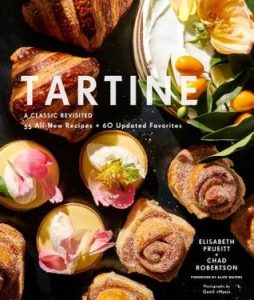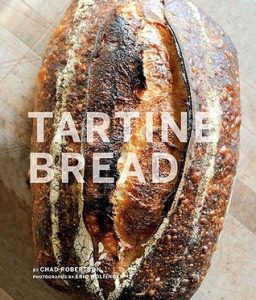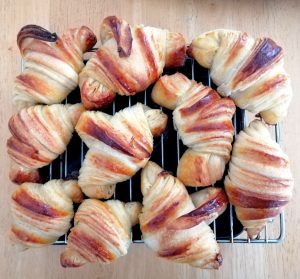 How’s the baking situation going on with you? Have you started a sourdough starter yet? Baked banana bread (or peanut butter bread)? I don’t know about you, but stress baking has reared its beautiful head and filled my house with bread! This post is going to be quite focused on one croissant recipe by a very famous bakery and me trying it out (though I think they’re more famous for their sourdough bread & recipe books than their croissants, to be honest): Tartine.
How’s the baking situation going on with you? Have you started a sourdough starter yet? Baked banana bread (or peanut butter bread)? I don’t know about you, but stress baking has reared its beautiful head and filled my house with bread! This post is going to be quite focused on one croissant recipe by a very famous bakery and me trying it out (though I think they’re more famous for their sourdough bread & recipe books than their croissants, to be honest): Tartine.
Have you heard of Tartine? It’s a bakery in San Francisco with a bit of a cult following among home bread bakers from what I have seen online. You might have heard reference made to their bread books in a reverential hushed whisper, or perhaps gushing enthusiasm that you’ll find might be hard to put a stop to once your conversation partner starts to go off on which breads they either want to make from the book (all of them) or which ones they’ve tried and how they came out (BEAUTIFUL CRUMB, LOOK AT THAT EAR, DELICIOUS BEYOND WORDS is the general tone – I have baked no Tartine sourdough recipes as of yet, but I can gush about Sullivan Street Bakery’s sourdough recipes, also high hydration, which have never led me astray; oh wait, I already have). I’ve personally mostly seen references to Tartine No.3*, which goes beyond the basics by focusing on specific grains outside of the generic bread flour or whole wheat flour you might find at your local grocery store. I’ll hook you up with some of the Tartine bread recipes below the cut sourced from the web, but we’re actually not here to discuss those sorts of carbs. No, we’re here today to talk about the buttery, flaky carbs that can be none other than the elegant and yet oh-so deceptively simple croissant. In fact, Prueitt, the author of this Tartine book, notes:
The real test of perfection is in the basic unadorned croissant, however… The cross section of a perfectly made croissant should have a center like honeycomb, with a discernible swirl pattern and a buttery, wheat-y, lightly-yeasted scent. The outside should be shatteringly crisp, contrasted with a center that is pillowy soft (Prueitt, Tartine: A Classic Revisited)
True that, Prueitt.
I’ve made my way through a number of different croissant recipes at this point, and if anyone’s interested in figuring out which to try depending on what you’re looking for in your croissants (flakiness? bread-like fluffiness?), leave a comment below and I’ll get back to you, but I’ll try to focus mostly on the one included in the new Tartine book** available on Hoopla in this post, which also has recipes for croissant variations (yes, this means you too can make their morning buns!), cakes, doughnuts, pies, and more! If stress-baking is your jam, 1) ME. TOO.; and 2) Tartine (and Hoopla) have got you covered.
 *We own neither Tartine No. 3 nor Tartine Bread, neither in-print (useless to us right now anyhow) nor electronically. It is both a tragedy and a grievous error that must be righted; I have taken it into my own hands to recommend we get both titles in electronic format. You’re welcome. CORRECTION/UPDATE: WE HAVE TARTINE BREAD NOW YOU’RE WELCOME.
*We own neither Tartine No. 3 nor Tartine Bread, neither in-print (useless to us right now anyhow) nor electronically. It is both a tragedy and a grievous error that must be righted; I have taken it into my own hands to recommend we get both titles in electronic format. You’re welcome. CORRECTION/UPDATE: WE HAVE TARTINE BREAD NOW YOU’RE WELCOME.
**We’ve actually got both the old and new editions on Hoopla, and while I haven’t gone through the two editions checking what’s different (apparently there are 68 new recipes in the new book + 55 classics), what I can tell you is this: if ever there was a time to try your hand at baking elaborate time-consuming recipes that take place over the course of more than one day, now is it!***
***What with the closures of facilities such as gyms and pools, you might think that stress-baking your way through these times is not the greatest idea, but let’s be real: when else are you going to have time to attend to a recipe that takes 2 – 3 days to complete from making your poolish that first night to pulling the deliciously browned-burnt-buttery-smelling croissants out of the oven? I don’t think I can accurately describe the aroma of freshly baked croissants as you pull them out of the oven, with some of the butter having melted onto the parchment paper, sizzling as it browns in the oven with that intoxicatingly sharp and alluring scent… it’s dangerous.
Before I continue on with the rest of this croissant review, let me just really quickly make good on my word above and list a few of the bread recipes available online from the Tartine bread books:
- Tartine’s Country Bread (NYT Cooking)
- Tartine’s Millet Porridge Sourdough (The Perfect Loaf – great resource for beginner & intermediate sourdough bakers alike)
- Actually, take a look through The Perfect Loaf for their Tartine recipe reviews and breakdowns – they’re very detailed, complete with a timeline to give you an idea how to prepare your dough throughout the day, and is chock full of photos

Tartine croissants, using substitutions (see below). Disappointing texture, but that’s on me.
Moving on: how did Tartine’s croissant recipe stack up against its reputation as being basically the holy grail of sourdough home baking? (Granted, this version of their croissant recipe doesn’t use a sourdough starter, going instead with a poolish, which uses commercial active dry yeast; and this dough is surely not representative at all seeing as it’s not a super high-hydration dough – which is what the Tartine sourdough recipes are known for being – so perhaps their croissants aren’t the best recipe to judge them by. Also, just a note that because we acquired Tartine Bread between when I wrote this and when it got published, everything below is based on the recipe in Tartine Revisited, not Tartine Bread, which is a quite a bit different, from using both poolish & a leaven (the sourdough starter) to incorporating also 81 layers instead of the paltry 12. But I digress.) I’ll just admit up front I couldn’t follow the recipe 100% because I just didn’t have some ingredients on hand (see below), and I definitely didn’t let them rise long enough in the final proof (for Tartine’s sake I hope that’s the reason behind the lackluster texture I got: zero honeycomb. The layers were there though, so it’s definitely just the length of time for that final proof, but this is very odd), but even given all the variables I introduced – forgive me for blaspheming – I think my heart stays with Poilâne for their croissant recipe.

For reference, my Poilâne croissants
- Poilâne is a lot less fussy, for one – mix it all, knead and throw it in the fridge overnight before laminating the next day – and their dough feels a lot easier to work with. Which is weird.
- Because in terms of recipe ratios, Poilâne and Tartine use the same ratio of flour to liquid (100%/60%). That being said, the Tartine croissants must be absolutely massive, because it calls for 985g total flour, resulting in 12 – 16 croissants, whereas with Poilâne calls for 495g flour to make… 14 croissants.
- If you halve the Tartine recipe, you basically get the Poilâne one, except Poilâne calls for a lot more sugar (55g to Tartine’s 70g for their full recipe) and
doubles the yeast (both recipes use the same amount of active dry yeast despite Tartine asking for about double the flour & liquid). - For size reference, Poilâne tells you to make triangles 4.25″ base and 10″ tall; Tartine asks for 3-4″ base and 10″ tall; fairly close in size. Given that they both make around the same number of croissants and yet Tartine calls for about double the flour & liquid that Poilâne does… Again, weird.
- If you halve the Tartine recipe, you basically get the Poilâne one, except Poilâne calls for a lot more sugar (55g to Tartine’s 70g for their full recipe) and
- Both recipes call for a rise time of around 2 hours (Tartine suggests 2-3 hours), which, given the yeast to other ingredients ratio, again, is weird. This might be where my substitution of instant for active dry yeast in the poolish mattered the most, though really it’s always just a “wait till it’s ready before baking” thing, and I followed the number rather than the dough, so that’s on me. I expect Tartine’s recipe should’ve yielded the honeycomb had I waited.
- Here’s the biggest difference between the two recipes: lamination. Whereas Tartine calls for one letter fold followed by one book fold, resulting in 12 layers, Poilâne calls for 4 letter folds in total: 81 layers. I’m actually not even sure if this is a mistake in the recipe instructions (did they just mean 3 letter folds in total rather than 3 turns in addition to the first letter fold? because most recipes stop at maybe 27 layers), but it worked. WHICH IS ALSO SO WEIRD.
All of this weirdness gets ironed out once you switch over to the croissant recipe in Tartine Bread, by the way. But I digress. Let’s go back to Tartine Revisited. This was my first time making a poolish (instead of just using my sourdough biga or plain up commercial instant yeast), and I’ll take this space here to list out my substitutions because there were many (all the same substitutions as I made for the Poilâne croissants though, I should note).
Almond Milk for Reduced-fat Milk Instant Yeast for Active Dry Yeast *I realize the instructions explicitly tell you "not instant", but this substitution has worked just fine for me in the past, whether it be sourdough or regular croissants, and the substitution is also corroborated by The Spruce Eats, The Kitchn, Serious Eats; King Arthur Flour. Giants, all of them. That being said, I should also note that I did not let the poolish sit overnight, instead opting for a 3-4 hour room temperature sit to double instead (ambient temperature chez moi leans cold) 75% All-purpose + 25% Wheat Atta Flour instead of Bread Flour *I have done this before with more than 3 croissant recipes and have found it works fine for me - I've gotten delicious croissants out of it, so this shouldn't be too big of an issue, though I suspect the texture won't be quite as good as if I used bread flour (Bread flour has more gluten, which allows for a better rise, though this is actually more complicated than just more gluten = good because there are more factors in play. Durum atta wheat flour is actually a topic of discussion for this because a number of posts I've read about sourdough recipes for this specific flour refer to its poor extensibility, resulting in poorly-risen loaves despite its high gluten content. For croissants, this shouldn't be much of an issue because we're not going for those sky-high rises that many sourdough loaves aim for, so we won't really even be testing how far we can stretch this flour without it breaking. Talk nerdy with me in the comments if you're also into bread and running low on specific flours at home!) Almond Milk for Heavy Cream (for egg wash) *Listen. I don't even have milk.
What am I even doing the same, you might ask? Literally just sugar, salt, unsalted butter, and egg yolks (for the egg wash). And the instructions.
The instructions are written out in a pretty clear format (though I personally prefer the ones in Tartine Bread & Poilâne both, because they’re a lot more straightforward and you add everything in all at once instead of in parts, which is unnecessary in my opinion considering the ratio of wet to dry ingredients anyway) and the e-book has photos to show you what the dough and folding process look like, as well as what it could look like if you had a machine to roll the dough out to a certain thickness for you: kind of like a pasta machine, except larger. And while the block of text may look foreboding and incredibly involved, it’s actually quite straightforward. You pound the butter and roll it out, put it between the dough and wrap it up, then fold like a letter and put in the fridge to rest, then roll it out again, fold like a book cover and put in the fridge to rest, then roll it out for the last time to cut it up into triangles and make into croissants. They’re not as difficult as they sound, and freshly baked croissants are definitely well worth the time and effort it takes! (The dough is similar enough to Poilâne’s that I can say this fairly confidently despite my mistake.)
For more stress baking inspiration, you can take a gander at the baking collection available on Hoopla Digital (a better selection than we’ve got on Overdrive in my opinion if you’re looking for recipe books, though there are baking and cooking titles on Overdrive as well).
Has your oven been considerably more chipper (and well loved) since physical distancing started? Have you been expanding your culinary repertoire? Started a sourdough starter yet? (If you have, then maybe check out these 100% sourdough croissants, which are delicious if not as flaky as Tartine or Poilâne’s.) Banana bread? It’s really just a matter of time at this point.